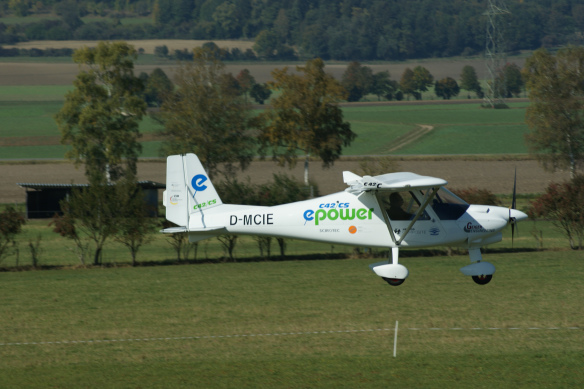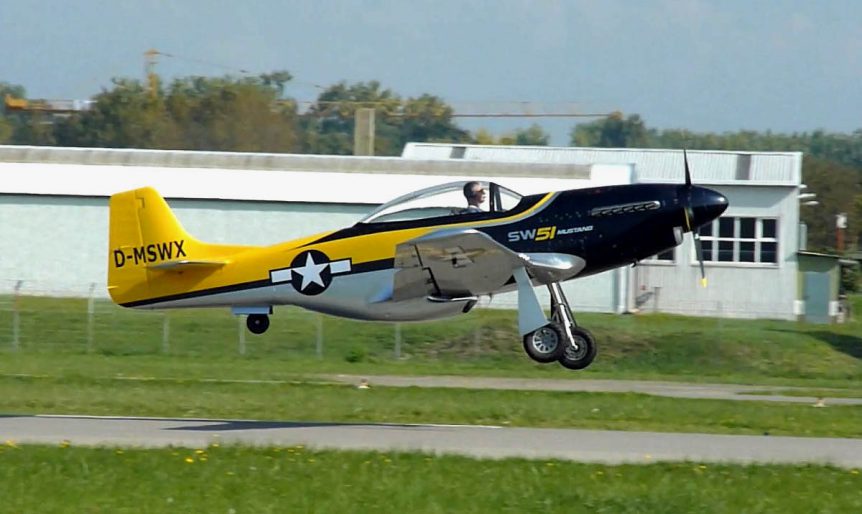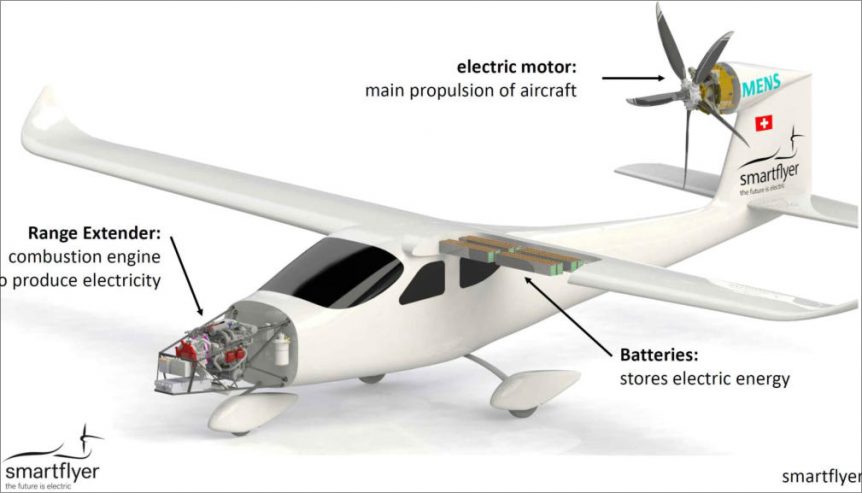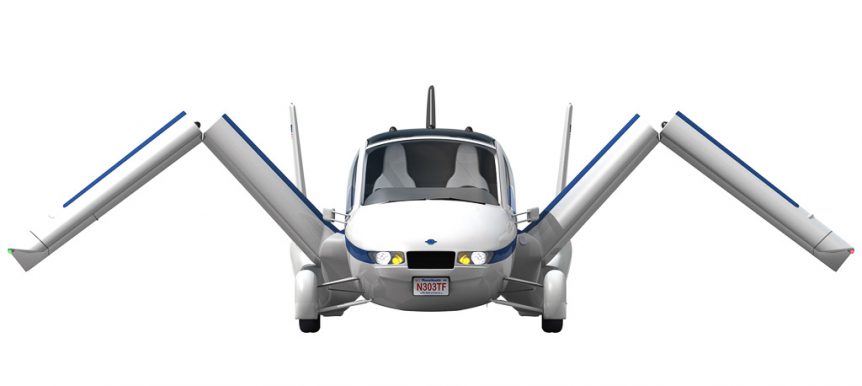The Comco Ikarus C42 is a popular ultralight aircraft in Europe, now being tested with a unique hybrid power system. Anton (Toni) Roth was an early adapter, putting small electric motors on a variety of ultralight aircraft over the past several years. These have been the lightest of machines powered by Eck/Geiger motors, controllers and batteries. His latest is a hybrid conversion of the popular C42, two-seat ultralight which normally flies on a Rotax engine, as do most European ultralight craft. In this case, Roth has mounted a Swiss single-cylinder four-stroke engine behind the pilot’s seats driving a Geiger generator which in turn powers a Geiger HP-55D motor on the nose, delivering up to 73 kilowatts (97 horsepower) and providing a rate of climb of five to six meters per second (584 to 1181 feet per minute) – an impressive performance for small aircraft. The engine, sipping a mere five liters (1.32 U. S. gallons) per hour, enables the generator …
A Triple-Redundant Powerplant
Your editor saw this Tweet from Frank Anton, head of Siemens eAircraft: FrankAnton @Frank_E_Anton Oct 9 Hybrid-electric with multiple redundancy: three independent drive units in one engine block. Should a module fail, flight can continue with two remaining components. Scalewings engine exists as concept, development work expected to take three years. This caused your editor to go quickly to the ScaleWings home page, where a beautiful P-51 Mustang in 70-percent scale dazzles. The airplane is available in Ultralight, Light Sport Aircraft, and Experimental configurations using engines from the UL and Rotax lines up to a Chevrolet LS300, with a supercharged variant offering up to 600 horsepower. Their brochure, in German or English gives a great overview of the features of this carbon-fiber replica. Scalewings has an even more exciting powerplant on the way, especially for those of us who value our own hides. Their triple-redundant engine/motor combines a naturally-aspirated four-stroke engine, a turbocharged four-stroke engine, and an electric motor. If any one …
SmartFlyer is Looking Smart
Only a design concept just a few years ago, the SmartFlyer hybrid aircraft is swiftly approaching full-fledged reality. CEO Rolf Stuber started the project and has been joined by Daniel Wenger, who shares design honors with him; and eleven others with a dazzling array of skills and degrees. Every member of the team has built, flies or has flown in everything from gliders to “heavy” airliners. The team’s goal is to craft a “proof of concept” airplane which will fly by 2021. Facebook Updates Recent Facebook photographs show a nose section with a Rotax 914 engine driving a special generator, yards of orange cable connecting the big pieces, and a set of formers for what will probably be the fuselage mold. smartflyer-challenge, 2nd edition this weekend visit the second fly-in for electric aircraft this weekend in Grenchen, Switzerland. The smartflyer team will be there. More info on https://www.smartflyer-challenge.com/ Posted by Smartflyer-aircraft on Monday, August 27, 2018 Pilots and passengers will …
Geely Looks Skyward, Buys Terrafugia
Geely is a huge enterprise, and while not the largest maker of electric cars in China, sold 766,000 gas and electric vehicles in 2016, growing 50 percent over the previous year. Its profits grew 126 percent last year, primarily due to sports utility vehicle (SUV) sales. As EV Obsession reports: “The 351,861 electric car sales registered in China during 2016 represent approximately 46% of ALL plug-ins sold worldwide this year, with Chinese carmakers responsible for 43% of all EV production in 2016.” Geely, surprisingly, owns Lotus, Malaysia’s Proton Motors, the firm that makes London’s iconic taxis, and Volvo. Volvo just announced that all its cars will be electric or hybrid starting in 2019. Fortune reports that the company has become highly profitable, with 2016 net returns doubling to 5.1 billion yuan ($741 million), and possibly rising to 7 billion yuan in 2017. What is a successful company to do with all that money? The South China Morning Post reports on one …
Eurosport Exploring New Configurations
Unhappily, we missed seeing Tom Leite at this year’s Electric Aircraft Symposium. Happily, he was at Eurosport Aircraft, his company in Portugal, working on innovative new approaches to making electric and hybrid motor-gliding a reality. He also has a speedster that would give those who desire rapid transit a high-style alternative. As shown in the video from Aero Friedrichshafen, the Crossover will probably trend toward a simpler wing configuration, with a fixed span of 18 meters (59 feet) and flaperons that will replace the multiple flaps on the current short-span version being flown in test flights. It’s uncertain whether the current twin-motors that pop out of the sides of the extremely slender fuselage will be retained, but a new version of the Crossover will feature three power options. As shown at Aero 2014, the airplane has the two options outlined on opposite sides of the fuselage – the port side displaying the Rotax-powered version, with a carbon-fiber shaft transmitting power …
Solar Ships – A Different Kind of STOL
A good many good ideas for aircraft seem to come from good ideas for serving mankind – with many aircraft and performance-enhancing features coming from the humanitarian or missionary world. A particular need for jungle aviation, or bush flying anywhere, is the capability to make short takeoffs and landing s (STOL). Jungles and mountain passes often present limited options for setting down, and being able to clear trees and pinnacles can be a life-saving necessity. Solar Ship advertises itself as an ultimate means of penetrating the wilderness. “No roads. No fuel. No infrastructure” sounds like a pipe dream, but seems to be heading toward practical reality, with test flights continuing on at least two prototypes. http://www.youtube.com/watch?v=awAAmwpdV70 Jay Godsall, CEO and co-founder of Solar Ship, Inc. has a cutting-edge medical background, having started and run an infectious disease barcoding firm, Fio. Dr. Sebastien Fournier, Chief Innovation Officer was CTO for Fio, helping develop and patent the world’s first method of bar-coding …
Hydrogen Scooters – A Possible Power Source?
Amateur aircraft builders, like Francis Marlier of the ULM Club in Alsace, France who recently converted his Exelec to a Sunexelec with the addition of solar cells, are always looking for reasonable options for powering their airplanes. Perhaps they could turn to fuel cells as a range extender. Several motor scooter makers are bringing out fuel-cell powered models that show some promise despite limited performance and high prices so far. Intelligent Energy, an English company, demonstrated a fuel cell scooter in 2005, and a number of aircraft developers, including Boeing, have crafted fuel-cell-powered vehicles. Intelligent Energy’s ENV was reportedly the world’s first purpose-built fuel cell motorbike, and Top Gear’s James May enjoyed the quiet ride, if only moderately endorsing the bike’s sedate performance. http://www.youtube.com/watch?v=igrKemNvxZQ Intelligent Energy’s entry for the Make It in Great Britain exhibit at the Science Museum gives a brief overview of proton exchange membrane fuel cell technology. “This award winning zero emission electric vehicle is powered by Intelligent …
A Comparison Too Far
A recent entry comparing the German Carplane® and Burt Rutan’s BiPod has prompted a response from John Brown, who found the posting of concern for the misapprehensions it might cause in readers. He notes, for instance, “Your current article portrays us as a large Govt. Co. (we got a small subsidy) going up against a ‘charity’ organization (Northrop-Grumman’s subsidiary, Scaled Composites) in whose name the BiPod is registered at the FAA – as a glider; “It compares us to 1930s modular concepts where actually the BiPod’s wings are screw-on/screw-off ‘modular’ and use that older concept; “It attributes a commuter ‘pitch’ to us where, in fact, we’re not aiming for that market at all. [Thanks for your apology. However, the world is still quoting your article.] “It implies we somehow responded to Burt Rutan (we disclosed 2008 – via patent). We’ve displayed at the world’s largest Trade Fair & Europe’s largest GA show – not at a desert strip. We’ve published …
Paris-Madrid Air Race 1911-2011
100 years ago, the idea of flying an 800-mile cross-country anywhere was a grand and dangerous adventure. With aerodynamics not yet a science and aircraft powered by the self-destructive engines of that day, it took a brave pilot to even make the attempt. The Paris-Madrid race of 1911 was a disaster from the start, and yet one man managed to achieve triumph despite the tragedy. 21 aviators were motivated to sign up in hopes of winning the 200,000 franc prize, but between May 21 and May 26, 1911, only six actually started, and only one flew the entire course. According to Transpress, a New Zealand blog, “After a full year of airshows, advertisers had become bored with seeing flying machines going in circles on a racetrack: they wanted city to city races, as was happening with automobiles. Funded and supported by the newspaper Le Petit Parisien, the international aviation race Paris-Madrid, despite the risks, attracted twenty-one competitors. The announcement of a …




